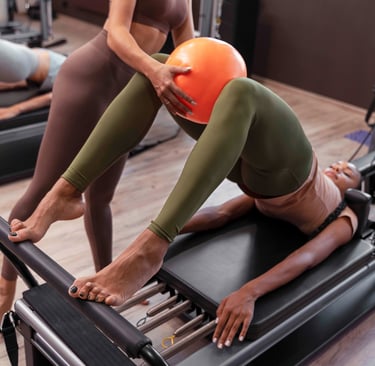What I Wish I Knew Before Teaching My First Pilates Class
Here are a few things my teacher training did not prepare me for Teaching Pilates. (Photo credit: Freepik.com)
PILATES THOUGHT PIECESTHE BUSINESS OF PILATESPILATES FOR PILATES INSTRUCTORS / PILATES TEACHERS / FITNESS INSTRUCTORSPILATES STUDIOS
Corie Kellman
6/11/20255 min read


Photo Credit: FreePik.com
Preparing for My First Pilates Class
When I started to teach full group Pilates classes, I felt anxious but confident. I was well into my Certification program, had taken hundreds of classes as a client, and had a background in training large groups in the consumer electronics space when I started to teach as an apprentice in a studio with 12 Reformer stations. But, there of of course, things that I wish I had known before starting to teach Pilates to group classes. This list is specific to group classes--I later learned Private training would be an entirely different experience.
A Class Plan Is A Map With A Lot Of Detours
A general class plan or format is essential to success, but I learned very quickly that it rarely goes as planned. I romanticized the idea of directing a class through a heavily planned and timed choreography, even down to the playlist. That sounds really fun, right? And it was, for me to dream up and play around with, until I realized how much time it was taking and how unrealistic it is in most settings.*
In open-booking Pilates classes, anyone with any condition, injury, or fitness level could drop in. This means that contraindications often prevent some from doing exercises planned, and for those who are new or having trouble getting into position will throw the timing off. Performing Pilates to the beat of a song also puts limitations on flexibility to provide corrections and can prevent someone from connecting their movement with their breath--one of the 6 principles of Pilates.
I learned to stop wasting hours outside of class preparing detailed class plans and shifted to prioritizing learning modifications and progressions and instead of planning classes in full, I would plan "blocks" for class that gave me flexibility to teach to the room and add or omit a block depending on how time was running. (Warm Up, Exercise Block 1, Exercise Block 2, Exercise Block 3, Exercise Block 4, Final Block)
*There are studios who specialize in this type of class. I opted to decline an interview at a studio like this based on my personal experience teaching for 5 years. These classes are not "wrong," they are just a very different experience and require a client and teacher who understands the pros and cons to it.
Bodies Are Resilient
My Pilates Teacher Training program scared me silly about special populations and contraindications. I was so scared I was going to injure someone if I didn't know everything about every injury or medical condition that walked in the room. I felt a great amount of pressure and it would take away from the quality of the class for everyone.
It is my ethical responsibility to keep everyone in class as safe as possible, but I am not a doctor or a physical therapist. Pilates helps bodies and is generally safe for all bodies with proper modifications, but it is not my job to heal someone or know exactly what they need to do. Ultimately, I learned that clients attending group class need to take ownership of their body, and their movement, and when I set that expectation at the start of class, they do. It is important to not be negligent, but treating someone like they are built of glass isn't helpful either. I keep an eye on all clients and look for cues of discomfort and safety concerns and take action when necessary, but stopped stressing the entire class about it-- bodies are not as fragile as training can sometimes seem.
Clients Motivations Will Vary
When I first started, I wanted to teach everyone to do the exercises "perfectly." What I learned over time is that no matter how hard I tried, especially in group class, this is not realistic and it is also not an accurate reflection on how good of a teacher I am.
People come to class for different reasons and motivations. Some might share the goal to learn Pilates with precision, but others might not care about that and instead values the class for a different reason. Some are there to improve their fitness, some are their to clear their minds, others come to feel a sense of community, etc. Once I learned this I was able to relieve myself of some of the pressure that everyone gets every exercise "right."
Authenticity Goes Far
I can't be everything to everyone, and I wish I had been okay with that sooner. I would sometimes go home and feel terrible that a person didn't look like they my enjoyed class or that I could sense they wanted something I was not giving to them that day. I spent too much time trying to be like other teachers. It never served me well. The idea that I wasn't enough and needed to be someone else perpetuated a toxic mindset and negatively affected my career progress. Once I started leaning into who I am and believing in the value of my teaching, my classes got better. Understanding that I cannot make everyone happy and that is okay also helped me in my professional life. There are plenty of styles of teaching out there and if I am not for you, there is a teacher who might be a better fit and that's okay--it doesn't make me lesser than them.
Feedback Is A Friend
While it is a non-negotiable for me to teach outside of my authenticity, it is important for me to understand areas that I can improve as a teacher. I was often afraid to ask for feedback, afraid someone would tell me they didn't like something that was core to who I am or ask me to be more like someone else. I also worked in a studio where the way that feedback was given was often done in a toxic way, so I was often scared to "get in trouble."
When I started to open direct communication, feedback felt healthier. I like to ask clients during the class things like, "How does that feel?" or "Where do you feel that the most?" to help me guide the room effectively. And at the end class I like to ask the question, "How does everyone feel?" I opened myself up to more compliments that I expected. I also created an atmosphere where clients felts safer to provide direct feedback and set the tone that I cared about their opinions, so I didn't have to worry about someone complaining to a studio manager later about something that was on their mind. Of course, there are times I still receive feedback that is not constructive or specific to the Pilates method and have to take some things with a grain of salt. Learning how to balance it is an ongoing journey.
If you are considering becoming a Pilates Instructor, don't miss out on this free resource!
Are you a new teacher looking for advice or mentorship? Or perhaps you are a seasoned teacher combatting burnout or insecurities? We are here to help. Your first 15 minute introduction call is free. Learn more here.
CONTACT US
© GRADUATE PILATES, LLC. 2025.
All rights reserved.
